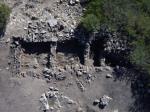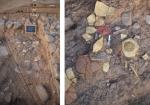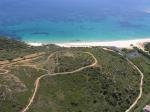Summary (English)
This was the first campaign of excavations on the site of Cuccureddus at Villasimius (CA) carried out by the University of Sassari in collaboration with the local administration and Villasimius Archaeological Museum.
This site was first excavated in the second half of the 1980s by Luisa Anna Marras. The new excavations uncovered some intact parts of the rectangular rooms dug in the 80s, and the area’s complex stratigraphy is providing a large amount of evidence for the Phoenician occupation, with the presence of transport amphora and other pottery, but above all with the identification of a series of collapses that seal these rooms overlooking the sea. The cleaning of the entire summit plateau made it possible to update the plan of the area, and ascertained the existence of a substantial wall about 3 m wide surrounding the entire summit of the lower hill of Cuccureddus, at c. 62 m a.s.l.
The 2017 investigation demonstrated the site’s great potential in terms of useful elements for the reconstruction of the diachronic occupation of this sector of south-eastern Sardinia, with specific reference to the Phoenician phases. Although excavation only took place in a limited area and inside structures already investigated in the past, the overall chronology of the site was confirmed. The first documented activities were quarry cuts and the construction of small rooms abutting a section of the external wall (not identified as obliterated by later collapse) during the middle Phoenician period, between the late 7th and early 6th century B.C. In the upper levels of the collapsed and then razed and levelled Phoenician structures there were layers of fill relating to a first reorganisation of the area that took place during the Roman Republican period (3rd/2nd – 1st century B.C.).
The Roman-Hellenistic levels must also have undergone substantial reorganization during the early imperial period, when there is an increase in the evidence, datable to between the 1st and 3rd centuries A.D. until the final horizons that date to the 4th or early 5th century A.D. At present, the Roman imperial period in particular is documented exclusively by the finds contained in the levels of terrain that were artificially cut and then re-compacted after the intervention of mechanical diggers that levelled the summit of the Cuccureddus hill in the 1970s.
- Michele Guirguis - Università degli Studi di Sassari
Director
- Michele Guirguis - Università degli Studi di Sassari
Team
- Elisabetta Gaudina - Museo Archeologico di Villasimius
- Ernesto Amedeo Insinna - Università degli Studi di Sassari
- Rosana Pla Orquín - Università degli Studi di Sassari
Research Body
- Dipartimento di Storia, Scienze dell’Uomo e della Formazione dell’Università degli Studi di Sassari
- Soprintendenza Archeologia, Belle Arti e Paesaggio per la città metropolitana di Cagliari e per le province di Oristano, Medio Campidano, Carbonia-Iglesias, Ogliastra - Area funzionale Patrimonio Archeologico
Funding Body
- Comune di Villasimius
- Dipartimento di Storia, Scienze dell’Uomo e della Formazione dell’Università degli Studi di Sassari
- Museo Archeologico di Villasimius






![Download [PDF]](/excavation/skins/fasti/images/results/download_sml.png)

